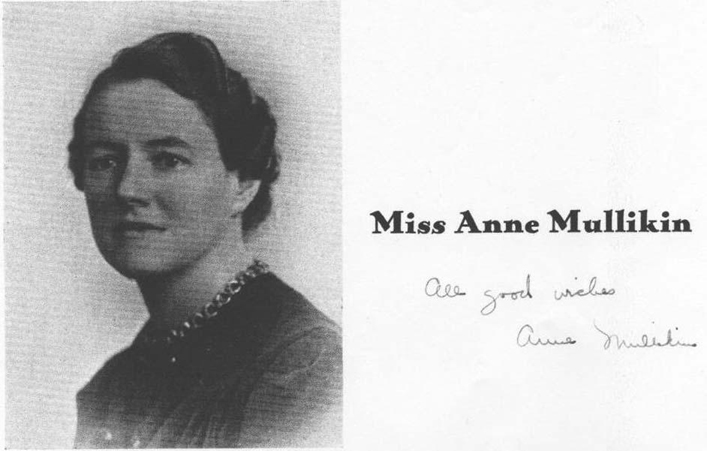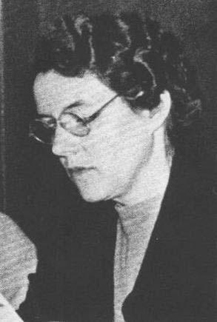- About MAA
- Membership
- MAA Publications
- Periodicals
- Blogs
- MAA Book Series
- MAA Press (an imprint of the AMS)
- MAA Notes
- MAA Reviews
- Mathematical Communication
- Information for Libraries
- Author Resources
- Advertise with MAA
- Meetings
- Competitions
- Programs
- Communities
- MAA Sections
- SIGMAA
- MAA Connect
- Students
- MAA Awards
- Awards Booklets
- Writing Awards
- Teaching Awards
- Service Awards
- Research Awards
- Lecture Awards
- Putnam Competition Individual and Team Winners
- D. E. Shaw Group AMC 8 Awards & Certificates
- Maryam Mirzakhani AMC 10 A Awards & Certificates
- Two Sigma AMC 10 B Awards & Certificates
- Jane Street AMC 12 A Awards & Certificates
- Akamai AMC 12 B Awards & Certificates
- High School Teachers
- News
You are here
Who Was Miss Mullikin? Teaching Career
Who Was Miss Mullikin?
Thomas L. Bartlow and David E. Zitarelli
The following article, which appeared in the American Mathematical Monthly, 116, no. 2 (February 2009): 99-114, is available as a PDF as well.
| Table of Contents | |
| 1 | Introduction |
| 2 | Dissertation |
| 3 | Mathematical Legacy |
| 4 | Teaching Career |
| 5 | Life and Family |
| 6 | Conclusion |
| 7 | Archival Sources |
| 8 | References |
4. TEACHING CAREER.
When Mullikin finished her Ph.D. in 1922, she went to work for the School District of Philadelphia as a teacher of secondary mathematics. She already had several years of teaching experience.
After her graduation from Goucher, she went to the Science Hill School, a private prep school for girls in Shelbyville, KY, for two years. Then she moved for one year to the Mary Baldwin Seminary, then a women's junior college in Staunton, VA, where she was the only full-time teacher of mathematics.
She took a year off from teaching during her first year at Penn, but in 1919-1920 she joined the faculty at the Stevens School, a private girls' prep school in the Germantown section of Philadelphia.
The following year she was in Texas teaching undergraduates, and in 1921-1922 she taught at the Oak Lane Country Day School, a private elementary school in the Philadelphia suburbs. Her first assignment in the Philadelphia School District was at the William Penn High School for Girls.
After one year she was transferred to a coeducational academic high school, Germantown High, where she remained until she retired in 1959. During this 36-year tenure she earned a reputation as a demanding, sympathetic, and effective teacher of mathematics. Figures 4 and 5 picture Miss Mullikin in a high-school yearbook from 1945, after she had switched her first name to Anne.
It also appears that after World War II she taught veterans who were filling colleges under the GI bill. Her report to the Goucher College Alumnae Association in 1949 mentions that she had been teaching part-time at "area colleges of the Commonwealth of Pa.," although we have not been able to determine which colleges these were or what she taught.
In 1952 Miss Mullikin was appointed Head of the Mathematics Department at Germantown High and a year later became "chairman of the Mathematics Advisory Committeeâ??a committee which determines the curriculum with respect to mathematics in the Junior and Senior High Schools" [A1]. During this time she became a textbook author, publishing Algebra and Its Use, Book I and Book II, written with Ethel L. Grove, who had taught at Cuyahoga High School in Cleveland, and Ewart L. Grove of the University of Alabama [14], [15].
Book I moves very carefully through different types of equations from x + a = b to quadratic equations with, according to the introduction, balance and equation as the "keynote." It is very much rule driven, with prescriptions followed by long exercise sets, the basic teaching strategy being practice in class followed by homework problems.
There is no mention of commutativity, associativity, or distributivity. Each variant on a type of equation has its own prescription with little indication of common features. One innovation is student-written word problems, p. 131. After Mullikin retired in 1959 she completed another book with the Groves, Basic Mathematics, published in 1961 [16].
In 1954 Goucher College held a science conference in conjunction with the dedication of the new Hoffberger Science Building. Several Goucher alumnae who had achieved distinction in the sciences were honored. The citation for Mullikin reads [3]:
Originator of the Mullikin theorem in point-set topology in the plane, inspiring and beloved teacher in the Germantown High School of Philadelphia, by your ability, patience, good humor, and enthusiasm you have imparted to hundreds of students a sure knowledge of elementary mathematics and its significance in modern life and thought. From the richness of your own mind you have developed in many of these young people the beginning of an appreciation for mathematical ideas.
Some of R.L. Moore's later students came to understand that he was "heartbroken" by Mullikin's decision to "waste her talents" as a high-school teacher [39, p. 242]. Jeanne LaDuke has written that some American women who earned a Ph.D. in mathematics in the early part of the twentieth century would "emphasize teachingâ??because they want to or because they are pushed in that direction" [13, p. xix]. Was Mullikin pushed or did she gladly choose to teach secondary mathematics?
Mullikin's own education at a women's college and her first three years teaching in women's institutions may have led her to envision herself as an educator of young women. She might have decided to pursue the Ph.D. to qualify for positions at women's colleges, which provided almost the only employment opportunities for scientific women in the early part of the twentieth century [42].
If so, she had changed her mind by the time she finished her degree in 1922, and was exploring positions in China. J.R. Kline wrote to R.L. Moore in September 1922, "Miss Mullikin is teaching in some girls high school in Philadelphia... Her China job did not materialize" [A5].
It is beyond the scope of this paper to attempt a conceptualization of the careers of American women Ph.D. mathematicians, but it is germane to compare Mullikin's career path with those of the other three women who received their degrees in 1921-1922.
Margaret Buchanan (1885-1965) graduated from West Virginia University before enrolling at Bryn Mawr College, where she wrote her dissertation under Anna Pell Wheeler. She then returned to her alma mater and taught there for the rest of her career. A West Virginia alumni award is named in her honor.
Claribel Kendall (1889-1965) received her bachelor's degree from the University of Colorado in 1912 and joined the faculty the next year while pursuing a master's degree, which she received in 1914. She attended the University of Chicago during summer sessions and ended up writing her dissertation there under Ernest Wilczynski. She remained at Colorado for the rest of her career.
Eleanor Pairman (1896-1973) was a human computer in Karl Pearson's Department of Applied Statistics at the University of London before enrolling at Radcliffe College, where she received her Ph.D. under G.D. Birkhoff. She and fellow graduate student Bancroft Huntington Brown were married in the same year their degrees were conferred. Mr. Brown was appointed to the faculty at Dartmouth College where Mrs. Brown found that she shared research interests with Rudolph E. Langer, with whom she published a joint paper [27].
In these two respects Pairman seems to be an exception among our four women; she is the only one who married and the only one who published anything other than her dissertation. The others, like Mullikin, remained single and embarked on teaching careers, albeit at their home universities.
We believe Miss Mullikin was drawn, not pushed, into secondary teaching. Her decision to teach in 1919-1920 and 1921-1922, when she had fellowship support from Penn, suggests that she enjoyed teaching. The reports of her students confirm that she took pleasure from their successes. She also had the model of her two older sisters who were both teachers in the Baltimore schools [1], [2].
Confirmation that Mullikin made a free choice comes from her student and friend Mary-Elizabeth Hamstrom, who attended Germantown High School from 1941 to 1944. Two years later, as an undergraduate at Penn, she wrote to Moore for information about his program at Texas. His reply closes with the request to extend greetings to Miss Mullikin quoted at the beginning of this article.
Hamstrom went on to take a Ph.D. from Moore at Texas and to become a distinguished research topologist at the University of Illinois. She has written to us that Mullikin found that "doing research was much too hard work for her tastes" and that Mullikin chose to teach in public schools because the pay was better than in private schools and colleges [19].
The citation quoted above from the 1954 Goucher Science Conference, probably written by Hamstrom, who was then on the Goucher faculty, praises Mullikin for her "patience, good humor, and enthusiasm." In a solid geometry class at Germantown H.S. in 1942 Hamstrom was challenged and encouraged by Mullikin. She "stimulated good students and was patient and pleasant... She was really pleased when a student solved a hard problem and showed it with a broad smile. She had a good supply of problemsâ??many hardâ??for good students" [19].
Other students agree. Three from the class of January 1945 have written to us. Earle W. Barber, Jr. recalls that students and faculty alike regarded her as one of the best teachers in the school, certainly the best in the mathematics department. She "treated all her students with respect" but "did not forgive those who did not do their homework."
At Germantown each class had a dual slate of officers, a young man and a young woman for each office, and two faculty advisors, one male and one female. For his class Barber was the male class president and Mullikin was the female advisor. He says that all the class officers found Mullikin more approachable and supportive than her male colleague but "she never let me get away with any shenanigans" [5].
Wallis D. Bolton recalls Mullikin as "gentle but firm... warm and friendly" [6]. He reports that she worked hard to develop mathematical competence in all her students but "took special pleasure in challenging those members [of her class] who were math-bright." He supports Barber's remark that she did not forgive slackers. Although he was one of the bright students and generally rose to Mullikin's challenge to earn an A, when he took a part-time job just before graduation and neglected his homework, he received a grade of C.
James Buck discloses that Mullikin had some of the talent-spotting ability for which her advisor Moore was famous. In tenth grade he was assigned to an algebra class for students of low ability. But Mullikin recognized that he could do better. "Each day she gave me separate, more complex homework assignments.... Miss Mullikin challenged me everyday... and brought me to being a straight A student in my math classes.... How she ever picked me out as having ability, I don't know" [7]. But it changed his life; he went on to a career in the new computer industry, working at IBM.
Continue to the next chapter: 5. LIFE AND FAMILY.






